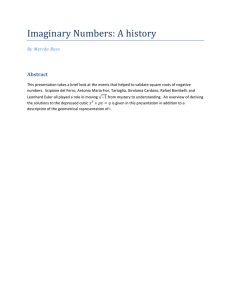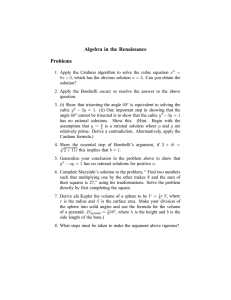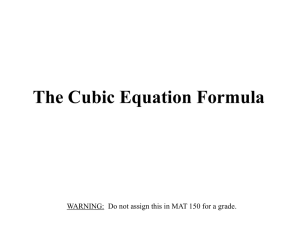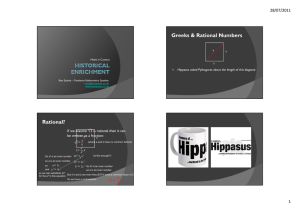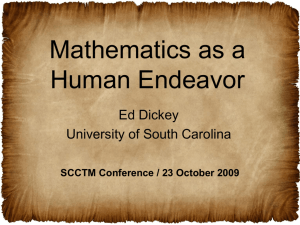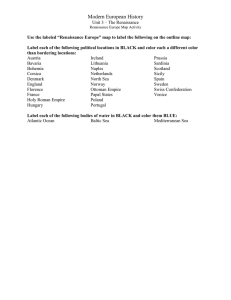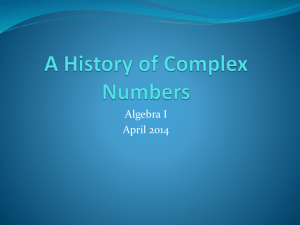Algebra in the Renaissance
advertisement
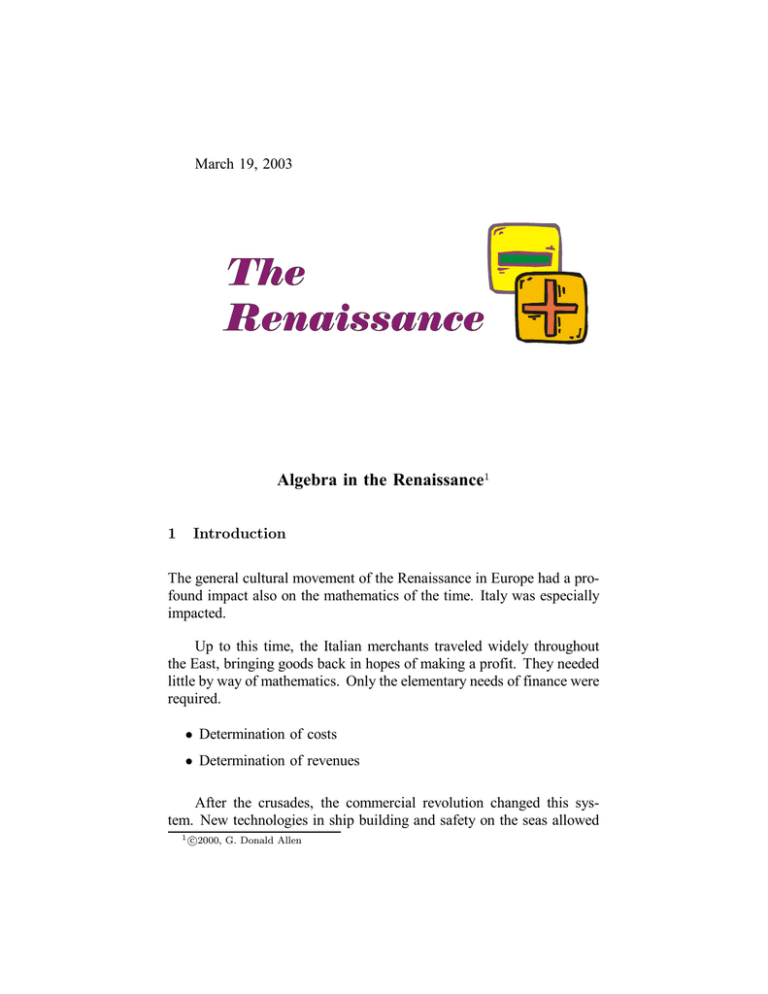
March 19, 2003 Algebra in the Renaissance1 1 Introduction The general cultural movement of the Renaissance in Europe had a profound impact also on the mathematics of the time. Italy was especially impacted. Up to this time, the Italian merchants traveled widely throughout the East, bringing goods back in hopes of making a profit. They needed little by way of mathematics. Only the elementary needs of finance were required. • Determination of costs • Determination of revenues After the crusades, the commercial revolution changed this system. New technologies in ship building and safety on the seas allowed 1 °2000, c G. Donald Allen The Renaissance 2 the single merchant to become a shipping magnate. These sedentary merchants could remain at home and hire others to make the journeys. Freed from the labor of travel, they now had time to make business deals. Thus they needed skills at financial capitalization, creation of instruments of credit, and generation of bills of exchange. At the base of all these was the computation of interest. Double-entry bookkeeping began as a way of tracking the continuous flow of goods and money. The economy of barter was slowly replaced by the economy of money we have today. Needing more mathematics, they inspired the emergence of a new class of mathematician called abacist, who wrote the texts from which they taught the necessary mathematics to the sons of merchants in schools created for just this purpose. There are hundreds still in existence. (Compare quadrivium (arithmetic, geometry, music, astronomy. Compare trivium: (grammar, rhetoric, and dialectics)). 2 The Italian Abacists The Italian abacists of the 14th century were instrumental in teaching the merchants the “new” Hindu-Arabic decimal place-value system and the algorithms for using it. There was formidable resistance to this system, in Italy and most of Europe. These abacists had thoroughly studied Arabic mathematics, which emphasized algebraic methods. In fact, for many years Roman numerals were used to keep account ledgers. The old system of counting boards required the board plus a bag of counters. The new system required only pen and paper. By and by, as with new technologies in general, the superior Hindu-Arabic system won out. This took centuries.2 Note. “Believe it or not” ....The decreasing costs and availability of paper was a factor in this. 2 Ever and even today a conservative group, bankers and financiers were reluctant to change their system of calculation from thoroughly tested and well understood procedures. The Renaissance 3 3 Mathematical Texts Mathematical texts were mostly practical, teaching only those problems young merchants would need in carrying out daily transactions. Problems and their solutions were described in detail, with all steps fully described. Besides the business problems required for their profession there were also recreational problems. There were problems in geometry, elementary number theory, the calendar, and astrology. The texts did not dwell on problems without a solution. Therefore, some student-teacher interaction would accompany the learning. During the 14th and 15th centuries the abacist extended the Islamic methods by introducing abbreviations and symbolisms, developing new methods for dealing with complex algebraic problems. Perhaps most important were the lessons learned in the use of algebra to solve practical problems. • Example. The gold florin is worth 5 lire, 12 soldi, 6 denarii in Lucca. How much (in terms of gold florins) are 13 soldi, 9 denarii worth. [One was given the relative worth of the soldi, denarii and lire (lira)3 .] • Example. A field is 150 feet long. A dog stands at one corner and a hare at the other. The dog leaps 9 feet in each leap while the hare leaps 7. In how many feet and leaps with the dog catch the hare. [Assume leaps are made consecutively in the same time.] Partly because of this practical need for mathematics the new direction of mathematics was toward algebraic methods. 3 The basis for comparison between these units varies over time, but during the reign of Cosimo I de Medici (in Florence) the following conversion applied: 1 gold ßorin was 3.54 grams of pure gold. Then a single gold ßorin is equivalent to 7 Lira. The Lira was worth 20 Soldii, and the Solda was worth 12 Denarii. The Renaissance 3.1 4 New Algebraic Techniques Unlike Islamic algebra, which was entirely rhetorical, the abacists allowed the use of symbols for unknowns. Standard words were: cosa censo cubo radice p̄ m̄ thing square cube root più (plus) meno (minus) From Antonio de’ Mazzinhi (1353-1383), known for his cleverness in solving algebraic problems, we have the example. “ Find two numbers such that multiplying one by the other makes 8 and the sum of their squares is 27.” The solution begins by supposing that the first number is un cosa meno la radice d’alchuna quantità (a thing minus the root of some quantity) while the second number equals una cosa più la radice d’alchuna quantità (another thing plus the root of some quantity). We have √ √ (x − y)(x + y) = 8 √ √ (x − y)2 + (x + y)2 = 27 Answer: x = 3.2 √ 43 , 2 y= 11 . 4 Solve the problem. Higher Degree Equations Another innovation of the abacists was their extention of the Islamic quadratic solving techniques to higher order equations. Of course, each text began with the standard six type of quadratics as described by Al-Khwarizmi. But many went further. Maestro Dardi of Pisa in a 1344 work extended this list to 198 types of equations of degree up to four, some involving radicals. He The Renaissance 5 gave an example of how to solve a particular cubic equation, but the methods would not generalize. Another mathematician of this age was Luca Pacioli (1445-1517), who was renown for his teaching, and his library with volumes collected over many years. He also collaborated with Leonardo da Vinci. 4 Renaissance Mathematicians Nicholas of Cusa (1401 - 1464) German Nikolaus Von Cusa, (Latin Nicolaus Cusanus), mathematician, scholar, experimental scientist, and influential philosopher stressed the incomplete nature of man’s knowledge of God and of the universe. He was ordained in 1440, became a cardinal in Brixon and in 1450 was elevated to bishop there. He was interested in geometry and logic. He contributed to the study of infinity, studying the infinitely large and the infinitely small. He also studied astronomy producing a book. For Nicholas, God and only God is absolutely infinite. The universe reflects this divine perfection by being relatively infinite, with no circumference and no center. Cusa is best known as a philosopher on the incomplete nature of mankind’s knowledge of the universe. He regarded the circle as the limit of regular polygons which he then applied in his religious teachings to demonstrate the nearness of yet the unattainability of truth. In other words, he claimed that the search for truth was equal to the task of squaring the circle. This second statement reveals the continuing and profound influence of the ancient Greeks on mathematicians and even upon the church itself. Among Cusa’s other interests were diagnostic medicine and applied science. He emphasized knowledge through experimentation, a break with Peripatetic views. He anticipated the work of the astronomer Copernicus by suggesting a movement in the universe not entirely geocentric in nature. In his study of plant growth, he concluded that plants absorb nourishment from the air. He also produced a map of Europe, and founded a hospital at his birthplace in 1458. The Renaissance 6 Johann Müller Regiomontanus (1436 - 1476) Regiomontanus was born Johann Müller of Königsberg but he used the Latin version of his name (Königsberg = ”King’s mountain”). Regiomontanus. At the age of fourteen he entered the University of Vienna. He became enchanted with all things mathematical and astronomical. Vowing to read Ptolemy’s Almagest in is original, Müller studied Greek in Italy and devoured all available texts, whether in Greek or Latin, whether on astronomy or mathematics. Upon his return to Vienna, he taught his new learning achieving phenomenal success. He was called to Nuremberg, where a sponsor built him a full scale observatory. His instruments were the finest, whether purchased or improved by himself. In a remarkable quote taken from a letter to another mathematician, we feel his total joy in mathematics and astronomy. “I do not know whither my pen will run; it will use up all my paper if I don’t stop it. One problem after another occurs to me, and there are so many beautiful ones that I hesitate as to which I should submit to you.” Regiomontanus was a true “Renaissance man”. He was a modern scientist with a love of classical learning. He set up a printing press, an observatory, and possessed a good library. In January 1472 he made observations of a comet which were accurate enough to allow it to be identified with Halley’s comet 210 years (and three returns of the 70 year period comet) later. He furnished a completed the Latin translation of The Almagest. He wrote Epitome of Ptolemy’s Almagest – commentaries on the mathematical portions. In 1464 he wrote De triangulis omnimodis (On Triangles of Every Kind) and early text on trigonometry in which he solved plane triangles, proved the law of sines, and gives and introduction to spherical geometry. His presentation is strictly classical, beginning with axioms and proofs following constructed on their basis. formulas given in rhetor- The Renaissance 7 ical form. The book was not published until about 1530 however. In Tabulae directionum, a trigonometric treatise, he furnished trigonometric tables. For his purpose he selected R = 600, 000 or 10,000,000 or 600,000,000. It includes tangent table with R = 100, 000 (e.g. tan 89◦ = 5, 729, 796). Actual: tan 89◦ × 100, 000 = 5, 728, 996. In 1475 Pope Sixtus IV summoned Regiomontanus to Rome to advise on calendar reform and to become bishop of Regensburg. However, just a year later he died before he could take office, most likely poisoned by his enemies. Nicolas Chuquet, (c. 1445 -c. 1500), a French physician, Chuquet wrote Triparty en la science des nombres (1484), a work on algebra and arithmetic in three parts. However, it was not printed until 1880. The mathematics in Triparty was known to the Islamic algebraists, but Triparty is the first detailed algebra in French. Below are a few details on the nature and style of this work. • Triparty – Part I – He uses the Hindu-Arabic place-value system – Use the result for fractions between: Given a, b, c, d > 0. Then a+c b+d is between ab and dc . e.g. 27 is between 12 and 15 . No proof is given. He uses this to approximate roots of quadratics. • Triparty – Part II √ – uses the fraction rule to extract square roots: Find 6. Solution. (1) 2 < r < 3. (2) 2 1/3 < r < 2 1/2. (3) 2 2/5, 2 3/7, 2 4/9, 2 5/11, 2 9/20. – introduces some notation • p̄-plus • m̄-minus, • underline for grouping, • R2 -square root, • R3 -cube root. So, q √ √ 2 2 R 6 = 6 R 14p̄R 180 = 14 + 80 2 The Renaissance 8 – allows negative coefficients • Triparty – Part III – introduces exponential notation .5.1 5x .6.2 6x2 .10.3 10x3 .9.0 9x0 .9.2.m 9x−2 (.9. second mains) Therefore, .72.1 party par .8.3 egualx .9.2.m – novelty .4.1 egualx m̄.20 4x = −2 – solves axm + 6xm+n = cxm+2n . This generalizes al Kashi. – notes that there are multiple solutions of some system of two equations in three unknowns. Luca Pacioli (1445 - 1517), an Italian, published a Latin translation of Euclid’s Elements , the first printed edition. He left unpublished a work on recreational problems, geometrical problems and proverbs. It makes frequent reference to Leonardo da Vinci who worked with him on the project. Pacioli was a teacher of some renown. He also assembled a vast collection of mathematical materials over some 20 years. Pacioli wrote Summa de arithmetica, geometrica proportioni et proportionalita (1494) It gives a summary of the mathematics known at that time. Summa studies arithmetic, algebra, geometry and trigonometry and provided a basis for the major progress in mathematics which took place in Europe shortly after this time. It overshadowed Chuquet’s Triparty but was not mathematically significant. Subsequently, Chuquet’s work was scarcely mentioned. The Renaissance 5 9 The German School Johann Widman (b. ∼1460), at the University of Leipzig wrote Rechnung auff allen Kauffmanschafften used + and − first time in print. This encouraged the use of these new symbols. Adam Riese (1492-1559), German, wrote Die Coss (1524), an influential arithmetic and algebra text. In Germany, the term “Das macht nach Adam Riese” still survives as German children know the expression meaning “that gives according to Adam Riese” when doing arithmetic. For income he wrote arithmetic textbooks. Rechenung auff der Linihen und Federn in zal, ma”s und gewicht auff allerley handierung ... is the most famous. Published in 1550, it was a textbook written for everyone, not just for scientists. It contains addition, subtraction, multiplication and division. This is remarkable because at that time division could only be learned at the university. Even many scientists did not know how to divide. Riese offered methods derived from the abacus those derived from India. The printing of this book came just after the Gutenberg printing press was invented. Many copies printed Christoph Rudolff, (ca. 1500-ca. 1545), German, wrote Coss (1525). In it he uses decimal fractions and modern notation for roots. Peter Apian, (1495-1552), German, wrote Rechnung (1527). In it we see Pascal’s triangle (!!) appears on title page — fully one century before Pascal. Michael Stifel (1487-1567), German monk turned itinerant Lutheran preacher; for a time a professor at Jena. We wrote Arithmetica integra (1544). It was the most important of the 16th century algebras: Features: • used the + and the −. • significant for treatment of negative numbers, radicals and powers • using negative coefficients. All the many cases of quadratics are reduced to just one, but no negative roots allowed The Renaissance 10 • irrationals. 6 The English School Robert Recorde, (1510 - 1558), an Englishman, virtually established the English school of mathematics and first introduced algebra into England. Recorde is best known for inventing the ‘equals’ symbol === which appears in his book The Whetstone of Witte (1557). Recorde was educated at Oxford and Cambridge. He became physician to King Edward VI and Queen Mary. He served for a time in Ireland as ’Comptroller of Mines and Monies’. He wrote many textbooks, for example The Grounde of Artes in 1540 was a very successful commercial arithmetic book teaching the “perfect work and practice of Arithmeticke etc”, in Recorde’s own words. The book discusses operations with Arabic numerals, computation with counters, proportion, the ‘rule of three’, and fractions. In 1551 Recorde wrote Pathwaie to Knowledge which some consider an abridged version of Euclid’s Elements. It is the only one of his books not written in the form of a dialogue between a master and scholar. The ’equals’ symbol === appears in Recorde’s book The Whetstone of Witte published in 1557. He justifies using two parallel line segments “bicause noe 2 thynges can be moare equalle”. The symbol === was not immediately popular. The symbol —— was used by some and ’ae’ ( or ’oe’ ), from the word ’aequalis’ meaning equal, was widely used into the 1700’s. Recorde died in King’s Bench prison in Southwark, where he was committed for debt. Although no official record remains of other crimes, some historians think he was guilty of much more serious offenses. Summary of notation The Renaissance 11 • P, P - plus;m, m - minus • unknown res chose cosa coss • +− • R2 , √ , square root • === 7 Chuquet and Pacioli (Latin) (French) (Italian) (German) Widman (ca. 1490) Rudolff (1525) Recorde (1557) The solution of the cubic Only a few years have now past since Andrew Wiles solved the famed Fermat’s Last Theorem.4 This problem, posed in the 17th century, was solved in the 20th century. In about 1540 the first analytical solution of a general cubic equation was determined. Mathematicians had been working toward the solution for at least 1500 years. Solving the cubic was one of the significant feats of the next few centuries that would unshackle the European mathematicians from their Greek heritage. The solution is richly intertwined with human endeavor not usually associated with mathematics. The cast of characters was singularly unsavory, with lies and genius co-mingled, with public disputes and contests, and with broken promises. • The Cast: Geronimo Cardano (1501-1576) Ars magna (1545) Niccolo Tartaglia (ca. 1500-1577) Ludovico Ferrari (1522-1565) 4 Consider the polynomial P (x, y, z) = xn + y n − z n . If n = 2, solutions of P (x, y, z) = 0 are Pythagorean triples. Given two integers m and n, it is easy to see that x = m2 − n2 , y = 2mn, and z = m2 + n2 forms a Pythagorean triple. If n ≥ 3 Fermat conjectured and in 1995 Andrew Wiles proved that there can be no integer solutions. This conjecture became known as Fermat’s Last Theorem. Wiles solved it in 1995. The Renaissance 12 Scipio del Ferro (ca. 1465-1526) • Also starring: Antonio Maria Fiore (1st half 16th century), student, Annibale della Nave (1500-1558), student Girolamo Cardano (1501 - 1576) is famed for his work Ars Magna which was the first Latin treatise devoted solely to algebra. Girolamo Cardano’s name was Cardan in Latin and in English he is sometimes known as Jerome Cardan. Cardano’s life was anything but conventional. In his professions, and there were several, his output was voluminous. He wrote 230 books. Of those 138 were printed. Others he burned. Among his works, he discussed painting and color in De subtilitate rerum (1551) and physical knowledge of the day in De rerum varietate (1557). One of his last works was his autobiography, De vita propria liber (A Book of My Own Life), is as singularly remarkable as a biography as Ars Magna is in algebra. Published when he was seventy four, he analyzes and confesses with startling candor his habits, character, mind, likes and dislikes, virtues and vices, honors, errors, illnesses, eccentricities, and dreams. He charges himself with obstinacy, bitterness, pugnacity, cheating at gambling, and vengefulness. He lists failures, particularly the proper rearing of his sons. A physician, he discusses his numerous, often surprising cures. He also reveals a great number of disabilities, including sexual disfunction, stuttering, palpitation, colic, dysentery, hemorrhoids, gout, and more. This was one of the very first modern autobiographies. Although we know him for his mathematics, his achievements in medicine were impressive and medicine was his favorite pursuit. Cardano studied at Pavia and Padua receiving a doctorate in medicine in 1525. He was professor of mathematics at Milan, Pavia and The Renaissance 13 Bologna leaving each after some scandal. Cardano lectured and wrote on mathematics, medicine, astronomy, astrology, alchemy, and physics. At the age of thirty four he lectured on mathematics, and at thirty five on medicine. His fame as a doctor was renown. In fact, he was so famous that the Archbishop of St Andrews in Scotland, on suffering as he thought from consumption, sent for Cardan. Cardano is reported to have visited Scotland to treat the Archbishop and cured him. Cardano is famed for his work Ars Magna (Great Art) which was the first Latin treatise devoted solely to algebra and is one of the important early steps in the rapid development in mathematics which began around this time (and still continues today). Ars magna made known the solution of the cubic by radicals and the solution of the quartic by radicals. These were proved by Tartaglia and Ferrari respectively. Ferrari was in fact a pupil of Cardan’s. We find in Ars Magna the first computation with complex numbers although Cardano did not properly understand it. The work was written completely in the rhetorical style, symbolism having not yet been invented. Cardano’s Liber de ludo aleae (1563) was the first study of the theory of probability. If anything, it is remarkable for its errors as well as truths. With Tartaglia and a century before Descartes, he considered the solution of geometric problems using algebra. Cardano made enemies by the score, and invited upon himself even more travails. He married miserably and fought unsuccessfully to save his son from execution for poisoning his unfaithful wife. He was at one time forbidden to lecture or publish books. In 1570 he was imprisoned on a charge of having cast the horoscope of Christ.5 In 1571 Pope Pius V granted him an annuity for life and he settled in Rome and became astrologer to the papal court. Cardano is reported to have correctly predicted the exact date of his own death — a prediction made true by his own suicide. 5 Possibly he was also imprisoned for debt. The Renaissance 14 Nicolo Fontana Tartaglia (1500 1557) was famed for his algebraic solution of cubic equations which was published in Cardan’s Ars Magna. During the French sack of Brescia (1512), his jaws and palate were cleft by a saber. The resulting speech difficulty earned him the nickname Tartaglia (”Stammerer”), which he adopted. Tartaglia was self taught in mathematics but, having an extraordinary ability, was able to earn his living teaching at Verona and Venice (1534). The first person known to have solved cubic equations algebraically was Scipio del Ferro. On his deathbed dal Ferro passed on the secret to his (rather poor) student Antonio Maria Fiore. A competition to solve cubic equation was arranged between Fior and Tartaglia. Tartaglia, by winning the competition in 1535, became famed as the discoverer of a formula to solve cubic equations. Because negative numbers were not used (and not even recognized) there was more than one type of cubic equation and Tartaglia could solve all types; Fior could solve only one type. Tartaglia confided his solution to Cardan on the condition that he would keep it secret, and with the implied promise of Cardano in the hope of becoming artillery adviser to the Spanish army. The method was, however, published by Cardan in Ars Magna in 1545. Tartaglia wrote Nova Scientia (1537) (A New Science) on the application of mathematics to artillery fire. He described new ballistic methods and instruments, including the first firing tables. As well, it is a pioneering effort at solving problems of falling bodies. Tartaglia also wrote a popular arithmetic text Trattato di numeri et misure, in three volumes (1556-60) (Treatise on Numbers and Measures), an encyclopaedic treatment of elementary mathematics. He was also the first Italian translator and publisher of Euclid’s Elements in 1543. He also published Latin editions of Archimedes’s works. From a poor family, Ferrari was taken into the service of the noted The Renaissance 15 Italian mathematician Gerolamo Cardano as an errand boy at the age of 15. By attending Cardano’s lectures, he learned Latin, Greek, and mathematics. In 1540 he succeeded Cardano as public mathematics lecturer in Milan, at which time he found the solution of the quartic equation, later published in Cardano’s Ars magna (1545; ”Great Art”). The publication of Ars magna brought Ferrari into a celebrated controversy with the noted Italian mathematician Niccolò Tartaglia over the solution of the cubic equation. After six printed challenges and counter challenges, Ferrari and Tartaglia met in Milan on Aug. 10, 1548, for a public mathematical contest, of which Ferrari was declared the winner. This success brought him immediate fame, and he was deluged with offers for various positions. He accepted that from Cardinal Ercole Gonzaga, regent of Mantua, to become supervisor of tax assessments, an appointment that soon made him wealthy. Later, ill health and a quarrel with the cardinal forced him to give up his lucrative position. He then accepted a professorship in mathematics at the University of Bologna, where he died shortly thereafter Ferrari, Ludovico (1522 - 1565) was orphaned at the age of fourteen. Having no formal education, he was sent as a refugee to Milan where he joined the household of Girolamo Cardano in 1536. At first he was an errand boy. Ferrari very likely showed exceptional promise, even before joining Cardano, and it is probable that this promise is what brought him to Cardano’s attention. Indeed, through his lectures Cardano introduced him to Latin, Greek, and Mathematics — not the normal course of training for an errand boy. He was promoted to the post of Cardano’s amanuensis, became his disciple, and ultimately collaborator. In 1540, he was appointed by Ferrante Gonzaga, the governor or Milan, public lecturer in mathematics in Milan. In so doing, he succeeded Cardano as public mathematics lecturer in Milan. In this capacity he gave lessons on the Geography of Ptolemy. He collaborated with Cardano in researches on the cubic and quartic equations, the results of which were published in the Ars magna (1545). Indeed, by all accounts, it was Ferrari who found the method of solving the quartic equation. The publication of Ars magna brought Ferrari into a well documented controversy with Tartaglia over the solution of the cubic equation. After six printed challenges and counter challenges, Ferrari and Tartaglia met in Milan on Aug. 10, 1548 for a public mathematical contest. Such challenges were common at that time as The Renaissance 16 learned men sought to gain new positions or defend their existing one. The procedure was for each contestant to offer a set of problems to the other for solution. The winner was declared to be he who answered the most questions. Ferrari was declared the winner of this one. This success brought him immediate fame and many offers for various positions. Ferrari accepted a position in the service of Ercole Gonzaga, Cardinal of Mantua, for some eight years (c. 1548 - 1556). Years later, in 1564, he returned to Bologna where he earned a doctorate in philosophy. From 1564 until his death in 1565, he was lecturer in mathematics at the University of Bologna. As an indication of his prominence, he received an offer from Emperor Charles V who wanted a tutor for his son. Scipione dal Ferro (1465 - 1525) lectured at Bologna where he was a colleague of Pacioli. Dal Ferro is the first to solve the cubic equation by radicals. He only solved one of the two cases (the fact that 0 and negative numbers were not in use made many distinct cases). He kept his discovery secret and only told his student Fior shortly before his death. Ferrari reports seeing a notebook in del Ferro’s handwriting where the solution is clearly written down. 7.1 The algorithm for the solution of the cubic The algorithm for the solution of the cubic requires a canonical form for the cubic, and this requires a preliminary transformation. • Transform ax3 + bx2 + cx = d into x3 + px = q, first dividing by a and then using the transformations6 x = y + β and then y = x. • Next define u and v by u − v = x and uv = 1 p. 3 This gives (u − v)3 + p(u − v) = q u3 − 3u3 v + 3uv 2 − v 3 + p(u − v) = q 6 Having divided out the lead coefficient a, define q (x) = x3 + bx2 + cx + d. We have q (y + β) = (y + β)3 + b (y + β)2 + c (y + β) + d = y 3 + 3y 2 β + 3yβ 2 + β 3 + by 2 + 2byβ + bβ 2 + cy + cβ + d. The coefficient of y 2 is 3β + b. Thus take β = − 3b to achieve the desired form. The Renaissance 17 u3 − v 3 − 3uv(u − v) + p(u − v) = q u3 − v 3 = q. p Using v = u, substitute to get: 3 (p/3)3 = q u3 − u3 u6 − qu3 = (p/3)3 (u3 )2 − q(u3 ) = (p/3)3 . Solve for u: u= q± q q 2 + 4(p/3)3 2 1/3 p and then for v; finally for x. Now compute v = u and then compute 3 x = u − v. After some simplification we obtain the form given by Cardano, namely x= rq 3 (p/3)3 + (q/2)2 + q/2 − However, his solution is rhetorical. 7.2 rq 3 (p/3)2 + (q/2)2 − q/2. Examples. Example 1. Solve x3 + 3x = 4. Solution. √ √ x = ( 1 + 4 + 2)1/3 − ( 1 + 4 − 2)1/3 √ √ = ( 5 + 2)1/3 − ( 5 − 2)1/3 = 1. Example 2. In Ars Magna we find x3 = 15x + 4. The solution here, by the formula, is q q √ √ 3 3 x = 2 + −121 + 2 − −121. The Renaissance 18 Cardano knew there was no square root of −121 and he knew x = 4 was a solution. He did not know to proceed. He referred to such square roots as “sophists”, and thought taking square roots of negative numbers was “as subtle as it is useless”. However, from this example Rafael Bombelli (ca. 1526-1573) made the first step toward complex numbers. Bombelli’s idea was that the radicals themselves might be related in much way that the radiq the √ 3 cans are related. In fact, notice that the terms 2 + −121 = 2 + 11i q √ and 3 2 − −121 = 2 − 11i are complex conjugates7 Therefore it is reasonable√to assume that the first of them has the form 2 + ib. If 2 + ib = 3 2 + 11i then it is a simple calculation8 to show that b = 1. Thus √ 2 + i = 3 2 + 11i √ 2 − i = 3 2 − 11i Hence, the root of the cubic is √ √ x = 2 + 1 −1 + 2 − 1 −1 = 4. What is remarkable is the Bombelli had not the slightest idea of complex numbers, except some (vague) intuition that the form might be invariant under algebraic operations. Cardano also posed the problem with complex roots x+y xy x y = = = = 10 40 √ 5 + −15 √ 5 − −15 7 Recall that the imaginary number i satisÞes i2 = −1. We say that the complex number c + di is the complex conjugate of a + ib if c = a and d = −b. ¡ ¢ 8 Technically, one cubes both sides to get (2 + ib)3 = 8 − 6b2 + i 12b − b3 and 2 + 11i, respectively. Now set the real parts equal, 8 − 6b2 = 2 and solve for b, obtaining b = ±1. We will take b = 1. The Þnal step is to substitute¯ this value of b into the imaginary parts and ¡ verify that equality obtains. Thus, 12b − b3 ¢¯ ¯ ¯ = 11 b=1 The Renaissance 7.3 19 Further comments. In connection with angle trisection we consider the following. cosθ = = = = à ! 2θ θ cos + 3 3 2θ θ 2θ θ cos cos − sin sin 3 3 à 3 ! 3 θ θ θ θ θ cos2 − sin2 cos − 2 sin2 cos 3 3 3 3 3 à ! à ! θ θ 2 θ 2 θ 2 cos − 1 cos + 2 cos cos − 1 . 3 3 3 3 So θ θ − 3 cos = cos θ. 3 3 The cosine of an angle and its trisection are related through the solution of a cubic. Consequently not only the cube-doubling problem but angle trisection problems are related to solving cubics. This fact, inspiring mathematicians to develop results about the constructibility of the solutions of cubic equations would lead to the ultimate resolution of these two great problems of antiquity. 4 cos3 7.4 Summary: We may say without reservation that the solution of cubic and quartic equations was • The greatest feat of algebra since ancient times • Not really practical – purely theoretical • Renewed interest in the trisection problem • Inspired work to solve general quintics ax5 + bx4 + cx3 + dx2 + ex + f = 0 The Renaissance 20 • Demanded awareness of negative and imaginary numbers – through the Tartaglia-Cardano formula. In the connection with imaginary numbers, we consider Rafael Bombelli (1526 - 1573) an engineer whose projects included reclaiming land. In mathematics, Bombelli was the first person to write down the rules for addition and multiplication of complex numbers. He showed that, using his methods, correct real solutions could be obtained from the Cardano-Tartaglia formula for the solution to a cubic. His work was strictly formal, though. He wrote Algebra in 1850, his only publication, a few years after the publication of Ars Magna. It was not published until 1872. It was nonetheless a very influential work and Leibniz cited Bombelli as an outstanding master of the analytical art. Features: • Published in five parts, only three in Bombelli’s life. • more systematic than Ars Magna — beginning with elementary material and moving up to cubics and quartics. • in the tradition of Pacioli’s Summa • uses considerable symbolism. (e.g. R.q. — square root, R.c. — cube root) There is even a symbol for powers. • Tied to the past in he solves many geometric problems, but algebraically. • Gives rules for evaluating complex numbers similar to the calculation above. From Boyer, we have “... we see that great milestones do not appear suddenly, but are merely more clear-cut formulations along the thorny path of uneven discovery.” The Renaissance 8 21 The Astronomers Nicolaus Copernicus (1473-1543) was born of a wealthy family in West Prussia, now Poland, and studied at the University of Cracow. Appointed to a clerical post, he received a salary and was free to travel to Italy to further his studies. He spent his life in Warmia as Canon of Frauenburg Cathedral. This job gave him sufficient free time to pursue his interests in astronomy. At this time the universe of Ptolemy was the currently accepted view. That is, the universe was composed of nested spheres centered at the Earth. There were also the eccenter and epicycle adjustments. However, by this time parts of the Ptolemaic system were difficult for astronomers to accept. Regiomontanus pointed out at least one error on the size of the moon, other predictions based on the system were found to be incorrect. Global navigation at that time required precise measurements and tables, and a precise theory. The discovery of so many new worlds also led to the conclusion that Ptolemy’s geography in error. The Renaissance 22 The Catholic Church noted that the Julian calendar, used since Roman times, was also in error. In fact the period of the earth was 11 1/4 minutes less than the 365 1/4 days it was based on. The seasons would soon be out of align with the calendar. Indeed, the vernal equinox was then on March 11, not March 21. The stage was set for a new theory — though the Church sought a calendar reform, not a new theory of the universe. Copernicus did not participate in the reform believing that a “fix” to Ptolemy was impossible, but rather read up on all the ancient teachings about a non-earth centered universe. He explored the consequences of such a system. His studies were published as De Revolutionibus Orbium Coelestium (On the Revolution of the Heavenly Spheres) in 1543, the year of his death. The work, which puts the sun at the center of the universe, is technical and detailed and includes many celestial observations made by himself and his predecessors. He describes the nature of the revolution of the planets and their moons. The concentric spheres were now for each of the planets about the sun. Curiously, there was at this time no physics to keep the planets in orbit!! Copernicus was still partly Aristotelian, the spheres moved in and of themselves. This issue was still below of “horizon of human consciousness”. Yet the Copernican simplification was not great. Much needed effort was required to overcome the basic spherical (circular) orbits he hypothesized. (epicycles, eccenters) Tycho Brahe (1546-1601) Better and better observational data was required, and astronomy found a champion in Tycho Brahe (1546-1601) who was precise to a fault. For years, after the new star in the constellation Cassiopeia had cause Tycho to rededicate his life to observational astronomy, he collected data. Before Tycho, astronomers did not methodically and systematically search the heavens or plot positions of the planets. Rather, they recorded first risings, oppositions, and the like called for by the existing theory. It was this data of neutral observations in the patient hands of Johannes Kepler that was to lead to the laws of planetary motion. The Renaissance 23 Tycho Brahe was a rather eccentric astronomer who spent much of his life improving observational data. Yet he was also an artist. Everything he undertook had to be innovative and beautiful. He built a print shop to produce and bind his manuscripts as he desired. He imported craftsmen to construct the finest astronomical instruments, and he paid Italian and Dutch artisans to design and decorate his observatory. All this required money. And Tycho found a generous sponsor in King Frederick II of Denmark. Frederick gave him the island of Ven in the middle of the sound halfway between Copenhagen and Helsingor. After Frederick died in 1588 Tycho’s influence dwindled. Under Frederick’s son Christian IV, most of his income was stopped for a variety of reasons, not the least of which was his increasing demands and decreasing services. Eventually, at odds with king, church, and nobility, Tycho left Ven in 1597 and settled in Prague under the patronage of Emperor Rudolf II in 1599, who also some years later supported the astronomer Johannes Kepler. His measurements were accurate to a couple of minutes of arc, far exceeding the best of work of any of the ancients. His precise observations, and his study of a nova, moved him to greatly doubt the Ptolemaic theory. Change was possible in the heavens. Though Tycho was primarily an observer, he has the wisdom to employ more theoretical thinkers. The most notable was Johannes Kepler. The Renaissance 24 Johannes Kepler (1571-1630) was born in Weil-der-Stadt in southwest Germany. He studied at Tübingen from 1587 to 1594 on a scholarship funded by the Duke of Württemberg. Originally intent on studying for the Lutheran ministry, he was influenced by Michael Maestlin’s lectures on Copernican astronomy. Frail and myopic, he soon became a militant supporter of the heliocentric philosophy. Completing his education, he took a position as the provincial mathematician and teacher in a Lutheran school in Graz. To supplement he took to “legitimate”9 astronomy by becoming involved in the preparation of an almanac of astrological forecasts. As most contemporary scientists and mathematicians of this time, the influence of the ancient teachings was particularly strong. Attempts to “model” this universe were made with tools of ancient days. For example, in Mysterium Cosmographicum (1597), Kepler poses the question: “Why are there six planets?” He answers thusly: Because God is the great geometer, he wanted to separate the planets with the regular solids. There were five such solids, and this is why God made six planets. He developed this thesis in some detail. Remarkably, this early model of a theological/mathematical heliocentric astronomy was very well received. For many, it fit well with extant knowledge, and importantly it was tied to ancient knowledge. A note of appreciation arrived from Galileo who received one of the two copies sent to Venice. At that time, Kepler may have had no direct knowledge of the young-ish Galileo Galilei (1564 - 1642), himself just establishing his own brilliant career. The copy sent to Tycho Brahe brought the young philosopher/mathematician to his attention.10 His greatest work was a result of a long collaboration and exami9 At this time astrology and astronomy co-mingled as a single subject. Kepler dismissed the former with contempt, believing it to be based on superstition. Recall, Cardano was an astrologer to the Papal court. 10 It is worthwhile to mention that the printing press at this time was barely more than a century old. Yet, it was already contributing to the rapid dissemination of knowledge, thereby accelerating progress and of course, criticism. Without the press, Kepler’s work may have gone unnoticed for decades or lost altogether. The Renaissance 25 nation with Tycho and his data. Working with Tycho’s observations of Mars, Kepler spent 8 years making calculations to predict its orbit. He tried everything. He tried eccenter models. He tried to obtain better measurements of the Earth. Finally, he struck pay dirt. Still basing his model on a circular orbit, he first discovered that “equal areas were swept out in equal times.” This is now known a Kepler’s second law. He gave an “infinitesimal” type of argument for it but realized that the proof was not rigorous. He discovered the elliptical path of the orbits when he finally rejected the circular orbit theory and adapted an “oval” orbit model. It was only when trying to measure the oval shape precisely that he used an ellipse to approximate it! In fact, the ellipse was exactly the oval shape that nature has commanded the orbits of her planets to obey. Therefore, that the orbit is elliptical is Kepler’s first law. He presents his results in Astonomia Nova in 1609. As an attempt to validate the Copernican hypothesis, it would not have survived had not the conclusions proved better than the best Ptolemaic predictions of the day. Indeed, the Copernican idea may have been forgotten, receding into history until new evidence forced its re-emergence. Incidently, the determination of the perimeter of the ellipse was still an open problem at this time. Kepler gave the approximation Pellipse = πa · b where a and b are the lengths of the semi axes. This is of course wrong; R π/2 √ the exact perimeter is given by the integral 4 0 a cos2 t + b cos2 tdt, and this formulation, even if given conceptually and rhetorically, would have been generally incomprehensible at the time. Kepler’s third law appeared in Harmonice Mundi, stated as an empirical fact based on empirical observation of Tycho’s data. It states: “The ratio of the period of two planets is directly proportional the 32 power of their mean distances from the sun. The discovery of Kepler’s laws provides a picture of just how science is often thought to be discovered. Formulate a hypothesis; test data against the hypothesis; correct the hypothesis; and repeat until agreement is reached. After Kepler and Galileo had finished their work, pointing to simple mathematical regularities as formal causes requiring little further analysis, all explanation was required to be mechanical. The Renaissance 26 The mechanical/mathematical model grew to dominate explanation of observable events — and so it continues to this day. Note however, remarkable as what they accomplished undoubtedly is, there was still no “physics” to hold the planets in orbit — to prevent them from crashing together or separating and proceeding on their own independent paths into the cosmos. It would take an even greater mind to propose the fundamental law that at once kept the planets in their place and forced their orbits to follow along those elliptical courses predicted by Kepler. That intellect was of course Isaac Newton (1642 - 1727), who drew his first breath the year Galileo died. Kepler also made advances in mathematics. For example, he determined volumes of wine barrels as volumes of revolution of sectors of circles. He also showed that the largest parallelepiped contained in a sphere is a cube. He gave a demonstration of the area of a circle to be A = 12 C r, where r is the radius and C is the circumference. See the diagram below. Each sector of the circle can be approximated by a triangle. The area of each sector is thus ∼ 12 r b, where b is the common base and r is the radius. Summing, the bases accumulate to approximately the circumference of the circle and hence the formula. 9 Problems 1. Apply the Cardano algorithm to solve the cubic equation x3 = 8x + 3, which has the obvious solution x = 3. Can you obtain the solution? The Renaissance 27 2. Apply the Bombelli ansatz to resolve the answer to the above question. 3. (i) Show that trisecting the angle 60o is equivalent to solving the cubic y 3 − 3y = 1. (ii) One important step in showing that the angle 60o cannot be trisected is to show that the cubic y 3 − 3y = 1 has no rational solutions. Show this. (Hint. Begin with the assumption that y = pq is a rational solution where p and q are relatively prime. Derive a contradiction. Alternatively, apply the Cardano formula.) 4. Show the essential step of Bombelli’s argument, if 2 + ib = √ 3 2 + 11i this implies that b = 1. 5. Generalize your conclusion in the problem above to show that y 3 − ay = 1 has no rational solutions for positive a. 6. Complete Mazzinhi’s solution to the problem, “ Find two numbers such that multiplying one by the other makes 8 and the sum of their squares is 27,” using his transformations. Solve the problem directly by first completing the square. 7. Derive alà Kepler the volume of a sphere to be V = 13 r S, where r is the radius and S is the surface area. Make your division of the sphere into solid angles and use the formula for the volume of a pyramid. (Vpyramid = 13 hb2 , where h is the height and b is the side length of the base.) 8. What steps must be taken to make the argument above rigorous?
